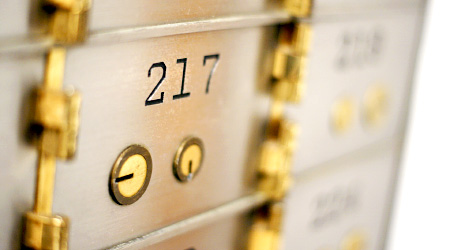Are Safety Deposit Boxes Really Secure?

Banks and credit unions throughout the nation normally provide safety deposit boxes to their customers in at least one location. This is primarily because safety deposit boxes are located inside vaults which require a minimum amount of space. If you have valuables or documents that need to be protected from theft or fire, then a safety deposit box is most likely your best solution. Some individuals feel having a safe at home is better but the cost and space required often make it unfeasible. Let's take a look at more specifics regarding safety deposit boxes, whether or not they are secure and what should be stored in one.
What is a Safety Deposit Box?
Think of the safety deposit box like those little Russian nesting dolls which have one inside another inside another. Normally a bank or credit union central branch will also have a primary walk-in vault which stores a large number of safety deposit boxes. An individual safety deposit box itself has a box inside of it for holding personal contents. For a financial institution to offer access to safety deposit boxes it is no small endeavor. It requires significant building infrastructure and security measures to be implemented to provide storage of and access to protected boxes for customer valuables. Safety deposit boxes have an annual fee ranging anywhere from $20-$80 per year depending on the safety deposit box's size. There are also specific privacy rooms allowing customers to remove or place their valuables within their safety deposit boxes.
Levels of Security
Safety deposit boxes are incredibly secure due to the many levels it takes to actually get to a box's contents. Banks and credit unions always have a certain level of security including closed circuit cameras, rapid law enforcement alerts, a security guard and various keys and magnetic stripe ID badges to limit access. And this is just to get into and access parts of the bank. Safety deposit boxes themselves are located in a hardened steel multiple inch-thick secured vault which is closed during nonworking hours. During working hours, access can only be granted into the vault by an employee escorting a customer personally. To verify the correct person has access, there is a photo ID verification and sign in log were signatures are matched. After all of this a customer can finally walk up to their safety deposit box but even this requires a specific key assigned to the customer. Along with the customer's safety deposit box key, the institution also has a master key and the two working together are then able to open a safety deposit box. As you can see there are a minimum of five different levels of security or verification limiting access to an individual customer's safety deposit box.
What You Should Store
Safety deposit box security isn't solely against theft or burglary. Their all metal construction and vault protection also guard against fire and natural disaster. With this level of security, any number of valuables can and should be stored in a safety deposit box. Car titles, house titles, wills, data backups, rare stamps, old coins, savings bonds, jewelry and any other items you don't want to risk losing is appropriate for safety deposit box storage. There are some things however which cannot and should not be stored such as anything that contains liquid or can degrade with time, firearms or other explosives and cash. It's not that you can't store $10,000 in cash in a safe deposit box it's just that it is unnecessary. All bank accounts are FDIC insured up to $250,000 and therefore even if the bank goes out of business, your money is still guaranteed by the federal government. If a financial institution does become insolvent, safety deposit box owners are notified and provided an opportunity to remove the stored contents.







